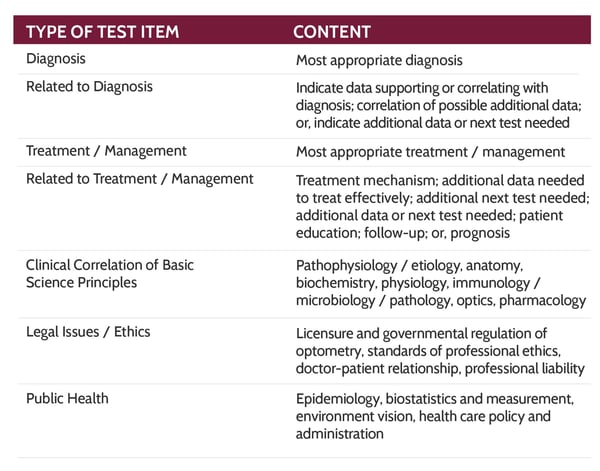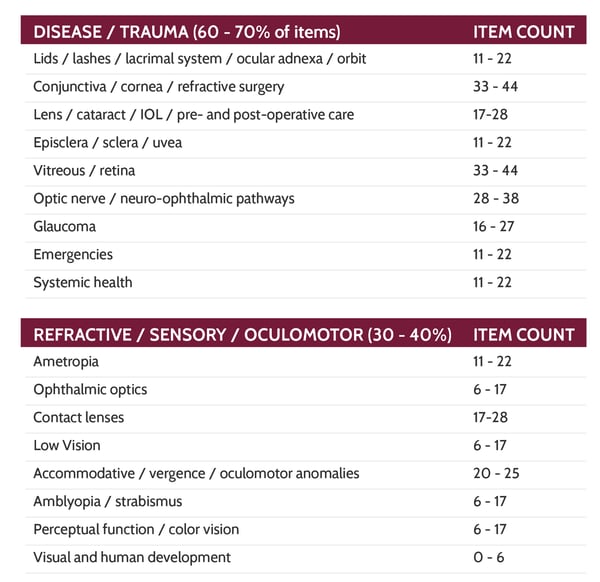
NBEO® Part II (also known as PAM – Patient Assessment & Management) is typically administered to optometry students in December of their 4th academic year.
For months prior to the examination, you will hear everyone talking about NBEO; what the exam entails, how many questions there are, what types of questions you’ll see, how the test is administered, etc., so we decided to put together a quick cheat-sheet with everything you need to know!
Test Administration
The PAM is a computer-based test (CBT) that is taken at a Pearson VUE testing center. There are over 200 testing centers throughout the country which make access to an exam center easy for most candidates. The PAM is offered on 2 dates during the December administration; however, students will only take the exam on a single day. Different versions of the PAM will be given on each of the two days, but they will be equivalent in content and difficulty level. The April administration of the PAM is only offered on a single day.
The examination is comprised of two sessions during testing day. Each session consists of approximately 175 items, with 3.5 hours allotted to complete them.. The morning session also includes an additional 15 minutes which is devoted to a tutorial and the reading and signing of a non-disclosure agreement (NDA). Students are also given an optional 45-minute break between the morning and afternoon testing sessions.
Exam Content
Testing items on the PAM are targeted to assess entry-level competence for an optometrist. Therefore, patient cases will generally focus on either typical presentations of relatively high frequency conditions, or conditions with low frequency but high criticality. The approximate distribution of testing items and description of the types of testing items are summarized below:

PAM Item Types
The PAM examination will consist of 45-55 full cases, 15-25 mini cases, and 15-20 solo question items. Each of these question types can include multiple response items.
- Full patient cases begin with a lengthy, comprehensive scenario in which patient history and clinical data are presented. This is followed by multiple supportive visuals which could include color ophthalmic photographs, contact lens fluorescein patterns, spectacle frame fitting problems, visual fields, or other ophthalmic instrument print-outs. There are 4-7 multiple choice questions that are then presented, each with 3-10 answer options. On the PAM examination, these cases are presented with a standard white background.
- Mini cases are an abbreviated version of a full patient case. These consist of a shortened patient scenario with 2-4 related questions. Most mini cases will also include one or more associated images. Mini cases appear on a pale orange background to help distinguish this section from the full patient cases and solo items.
- Solo items are relatively straight-forward, knowledge-centric, independent entities. They include a single question with 3-7 answer options. Solo items are presented on a pale blue background.
TMOD
Approximately 100-125 of the 350 PAM items are categorized as TMOD (Treatment and Management of Ocular Disease). In order to be classified as a TMOD item, the content of the item must pertain to one or more of the following:

Additional Information
- Some patient cases in the PAM exam may include normal clinical photos and/or visuals. So don’t worry if you don’t see anything abnormal! That may be on purpose!
- When visual field images are displayed side-by-side, with the right visual field on the right and left on the left, the image numbers will appear to be out of sequence. This occurs because images are numbered sequentially as referenced in the case history and OD is always referenced before OS. So, don’t get this confused! It is not a typo!
- Not all questions within a patient case refer to the depicted patient. So read the question stem carefully! E.g. “Which of the following is the most likely cause of this condition in the general population?”
- Individual drugs included in the PAM are referenced by generic or trade name, but not both. During the exam, students will have access to a searchable drug list.
- There are practice cases available on the NBEO website!
While this information is a summary of what we think is important for you to know about the PAM examination, you should still visit the NBEO website for more details.
